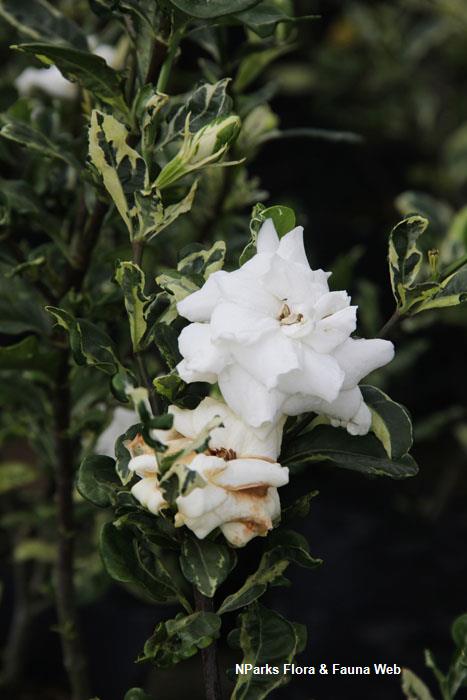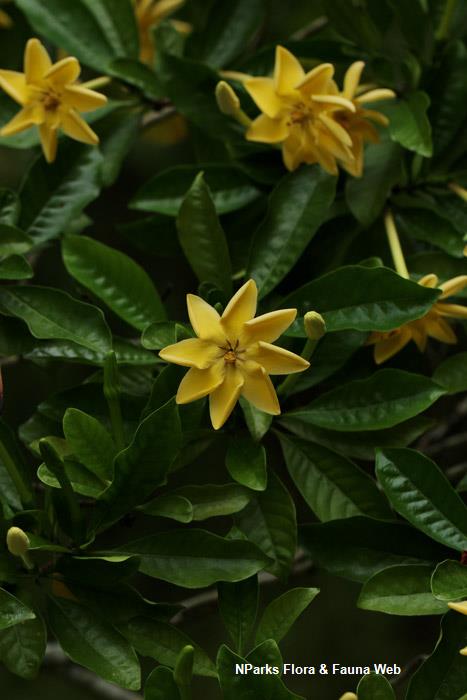
Name
Classifications and Characteristics
| Plant Division | Angiosperms (Flowering Seed Plants) (Dicotyledon) |
|---|---|
| Plant Growth Form | Shrub |
| Lifespan (in Singapore) | Perennial |
| Mode of Nutrition | Autotrophic |
Biogeography
| Native Distribution | Southwest Pacific. |
|---|---|
| Native Habitat | Terrestrial |
| Preferred Climate Zone | Tropical |
| Local Conservation Status | Non-native (Horticultural / Cultivated Only) |
Description and Ethnobotany
| Growth Form | An evergreen shrub or a small tree that can grow up to 6 m tall. |
|---|---|
| Foliage | Leaves are oppositely arranged along the stem, congested near the branch tips; leaf blade is obovate to broadly elliptic, measuring 3.5 - 24 cm long and 2.5 - 6 cm wide, glabrous on both surfaces, shiny on the above. Apex is round or obtuse to broadly acuminate, base is acute to cuneate and decurrent. Stipules are 3 - 12 mm long, broadly triangular or obtuse and united at the bases, while on the young stems they appear cup-like. |
| Flowers | Solitary flowers. Large white, pinwheel flowers, fragrant, about 7.5 cm in diameter (sometimes up to 10 cm). |
| Fruit | Fruits are broadly ellipsoidal to subglobose, measuring 35 - 50 mm long and 30 - 40 mm wide, 4 - 5 ribbed, has persistent calyx lobes and cup at the apex. When ripens, fruit splits irregularly to reveal numerous seeds in bright orange pulp. |
| Others - Plant Morphology | Plant identification for this record was provided by Low Yee Wen of SING herbarium. Official flower of Tahiti. |
| Habitat | Grows in woodlands and thickets, near coasts and sometimes on limestones. |
| Cultivation | Avoid misting the plant as it can result in fungal leaf spot. Plant requires moderate watering, make sure soil doesn't completely dry out. Fertilize gardenias monthly with balanced fertilizer. Remove any disease, dead or spent flowers. Plant can be pruned to maintain plant's shape. |
| Etymology | The genus Gardenia is named after Dr. Alexander Garden, an Anglo-American botanist, correspondent with Linnaeus. |
| Ethnobotanical Uses | Medicinal: Infusion of bark and flower in water or coconut oil for antiseptic, anti-inflammatory and other medicinal uses. Cultural / Religious: Polynesian people used the flowers as leis. In some Pacific island traditions, flower worn on left ear means the person is taken while on the right ear means available. Others: The wood can be carved into netting needles and bows. |
Landscaping Features
| Desirable Plant Features | Ornamental Flowers, Ornamental Foliage, Fragrant (Flowers) |
|---|---|
| Landscape Uses | Parks & Gardens, Small Gardens, Hedge / Screening, Container Planting |
Fauna, Pollination and Dispersal
| Pollination Method(s) | Biotic (Fauna) |
|---|
Plant Care and Propagation
| Light Preference | Full Sun |
|---|---|
| Water Preference | Moderate Water |
| Rootzone Tolerance | Moist Soils, Well-Drained Soils, Fertile Loamy Soils |
Foliar
| Foliage Retention | Evergreen |
|---|---|
| Mature Foliage Colour(s) | Green |
| Mature Foliage Texture(s) | Smooth, Glossy / Shiny |
| Prominent Young Flush Colour(s) | Green |
| Young Flush Texture(s) | Smooth |
| Foliar Modification | Stipule |
| Foliar Type | Simple / Unifoliate |
| Foliar Arrangement Along Stem | Opposite |
| Foliar Attachment to Stem | Petiolate |
| Foliar Shape(s) | Non-Palm Foliage (Obovate, Elliptical) |
| Foliar Venation | Pinnate / Net |
| Foliar Margin | Entire |
| Foliar Apex - Tip | Obtuse, Rounded |
| Foliar Base | Acute, Cuneate |
Floral (Angiosperm)
| Flower Colour(s) | White |
|---|---|
| Flower Texture(s) | Smooth |
| Flower Grouping | Solitary |
| Flower Symmetry | Radial |
| Individual Flower Shape | Tubular, Stellate / Star-shaped |
| Flowering Period | Free-Flowering |
Fruit, Seed and Spore
| Mature Seed Colour(s) | Brown, Yellow / Golden |
|---|---|
| Seed Description | Brownish yellow, irregular discoid. About 4 mm in diameter and 0.5 mm thick. |
Image Repository
Others
| Master ID | 31573 |
|---|---|
| Species ID | 5972 |
| Flora Disclaimer | The information in this website has been compiled from reliable sources, such as reference works on medicinal plants. It is not a substitute for medical advice or treatment and NParks does not purport to provide any medical advice. Readers should always consult his/her physician before using or consuming a plant for medicinal purposes. |













